Eight-Channel LAN WDM (De)Multiplexer Based on Cascaded Mach–Zehnder Interferometer on SOI for 400GbE
Abstract
1. Introduction
2. Design and Fabrication
3. Device Characterization
4. Conclusions
Author Contributions
Funding
Data Availability Statement
Conflicts of Interest
Abbreviations
| MZI | Mach–Zehnder interferometer |
| LAN | Local Area Network |
| WDM | Wavelength Division Multiplexing |
| MMI | multi-mode interference |
| AWG | arrayed-waveguide grating |
| EDG | echelle diffraction grating |
| CWDM | Coarse Wavelength Division Multiplexing |
| SiN | silicon nitride |
| PSR | polarization splitter rotator |
| FDE | finite-difference eigenmode |
| EME | eigenmode expansion |
| IL | insertion loss |
| PECVD | plasma-enhanced chemical vapor deposition |
| ASE | amplified spontaneous emission |
| OSA | optical spectrum analyzer |
References
- Brackett, C.A. Dense wavelength division multiplexing networks—Principles and applications. IEEE J. Sel. Areas Commun. 1990, 8, 948–964. [Google Scholar] [CrossRef]
- 200 Gb/s and 400 Gb/s Ethernet Task Force. Available online: http://www.ieee802.org/3/bs/ (accessed on 20 October 2021).
- Akca, B.I.; Doerr, C.R.; Sengo, G.; Worhoff, K.; Pollnau, M.; de Ridder, R.M. Broad-spectral-range synchronized flat-top arrayed-waveguide grating applied in a 225-channel cascaded spectrometer. Opt Express 2012, 20, 18313–18318. [Google Scholar] [CrossRef] [PubMed][Green Version]
- Pathak, S.; Vanslembrouck, M.; Dumon, P.; Thourhout, D.V.; Bogaerts, W. Optimized Silicon AWG With Flattened Spectral Response Using an MMI Aperture. J. Lightw. Technol. 2013, 31, 87–93. [Google Scholar] [CrossRef]
- Shi, W.; Yun, H.; Lin, C.; Greenberg, M.; Wang, X.; Wang, Y.; Fard, S.T.; Flueckiger, J.; Jaeger, N.A.F.; Chrostowski, L. Ultra-compact, flat-top demultiplexer using anti-reflection contra-directional couplers for CWDM networks on silicon. Opt. Express 2013, 21, 6733–6738. [Google Scholar] [CrossRef] [PubMed]
- Oguma, M.; Kitoh, T.; Shibata, T.; Inoue, Y.; Jinguji, K.; Himeno, A.; Hibino, Y. Four-channel flat-top and low-loss filter for wide passband WDM access network. Electron. Lett. 2001, 37, 514–515. [Google Scholar] [CrossRef]
- Horst, F.; Green, W.M.; Assefa, S.; Shank, S.M.; Vlasov, Y.A.; Offrein, B.J. Cascaded Mach-Zehnder wavelength filters in silicon photonics for low loss and flat pass-band WDM (de-)multiplexing. Opt. Express 2013, 21, 11652–11658. [Google Scholar] [CrossRef] [PubMed]
- Jeong, S.H.; Shimura, D.; Simoyama, T.; Horikawa, T.; Tanaka, Y.; Morito, K. Si-nanowire-based multistage delayed Mach-Zehnder interferometer optical MUX/DeMUX fabricated by an ArF-immersion lithography process on a 300 mm SOI wafer. Opt. Lett. 2014, 39, 3702–3705. [Google Scholar] [CrossRef] [PubMed]
- Tao, S.; Huang, Q.; Zhu, L.; Liu, J.; Zhang, Y.; Huang, Y.; Wang, Y.; Xia, J. Athermal 4-channel (de-)multiplexer in silicon nitride fabricated at low temperature. Photonics Res. 2018, 6, 686–691. [Google Scholar] [CrossRef]
- Pan, P.; An, J.; Wang, Y.; Zhang, J.; Wang, L.; Qi, Y.; Han, Q.; Hu, X. Compact 4-channel AWGs for CWDM and LAN WDM in data center monolithic applications. Opt. Laser Technol. 2015, 75, 177–181. [Google Scholar] [CrossRef]
- Mikkelsen, J.C.; Bois, A.; Lordello, T.; Mahgerefteh, D.; Menezo, S.; Poon, J.K.S. Polarization-insensitive silicon nitride Mach-Zehnder lattice wavelength demultiplexers for CWDM in the O-band. Opt. Express 2018, 26, 30076–30084. [Google Scholar] [CrossRef] [PubMed]
- Xu, H.; Liu, L.; Shi, Y. Polarization-insensitive four-channel coarse wavelength-division (de)multiplexer based on Mach-Zehnder interferometers with bent directional couplers and polarization rotators. Opt. Lett. 2018, 43, 1483–1486. [Google Scholar] [CrossRef] [PubMed]
- Xu, H.; Dai, D.; Shi, Y. Low-crosstalk and fabrication-tolerant four-channel CWDM filter based on dispersion-engineered Mach-Zehnder interferometers. Opt. Express 2021, 29, 20617–20631. [Google Scholar] [CrossRef] [PubMed]
- Gao, G.; Chen, D.; Tao, S.; Zhang, Y.; Zhu, S.; Xiao, X.; Xia, J. Silicon nitride O-band (de)multiplexers with low thermal sensitivity. Opt. Express 2017, 25, 12260–12267. [Google Scholar] [CrossRef] [PubMed]
- Hassan, K.; Sciancalepore, C.; Harduin, J.; Ferrotti, T.; Menezo, S.; Bakir, B.B. Toward athermal silicon-on-insulator (de)multiplexers in the O-band. Opt. Lett. 2015, 40, 2641–2644. [Google Scholar] [CrossRef] [PubMed]
- Fujisawa, T.; Takano, J.; Sawada, Y.; Saitoh, K. Low-Loss and Small 2 × 4λ Multiplexers Based on 2 × 2 and 2 × 1 Mach–Zehnder Interferometers With On-Chip Polarization Multiplexing for 400GbE. J. Lightw. Technol. 2021, 39, 193–200. [Google Scholar] [CrossRef]
- Jeong, S.-H. Broadband 1 × 8 channel silicon-nanowire-waveguide WDM filter based on point-symmetric Mach-Zehnder interferometric optical couplers in the O-band spectral regime. OSA Continuum. 2019, 2, 3564–3575. [Google Scholar] [CrossRef]
- Munk, D.; Katzman, M.; Kaganovskii, Y.; Inbar, N.; Misra, A.; Hen, M.; Priel, M.; Feldberg, M.; Tkachev, M.; Bergman, A.; et al. Eight-Channel Silicon-Photonic Wavelength Division Multiplexer With 17 GHz Spacing. IEEE J. Sel. Top. Quant. 2019, 25, 1–10. [Google Scholar] [CrossRef]
- Jeong, S.-H.; Tanaka, Y. Silicon-wire optical demultiplexers based on multistage delayed Mach-Zehnder interferometers for higher production yield. Appl. Opt. 2018, 57, 6474–6480. [Google Scholar] [CrossRef] [PubMed]
- Xu, H.; Shi, Y. Flat-Top CWDM (De)Multiplexer Based on MZI With Bent Directional Couplers. IEEE Photonics Technol. Lett. 2018, 30, 169–172. [Google Scholar] [CrossRef]
- Chang, L.; Gong, Y.; Liu, L.; Li, Z.; Yu, Y. Low-Loss Broadband Silicon-on-Insulator Demultiplexers in the O -Band. IEEE Photonics Technol. Lett. 2017, 29, 1237–1240. [Google Scholar] [CrossRef]
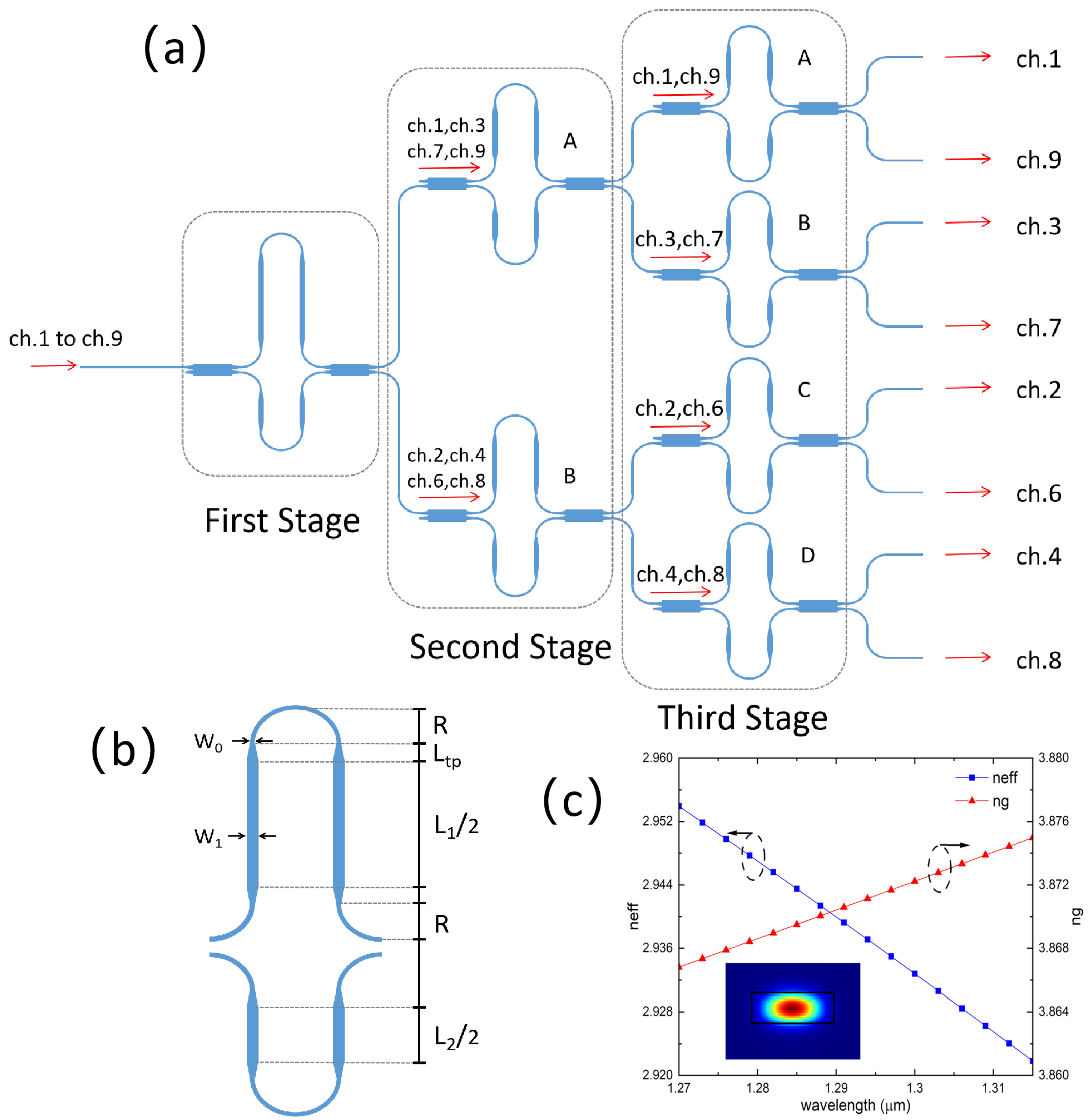
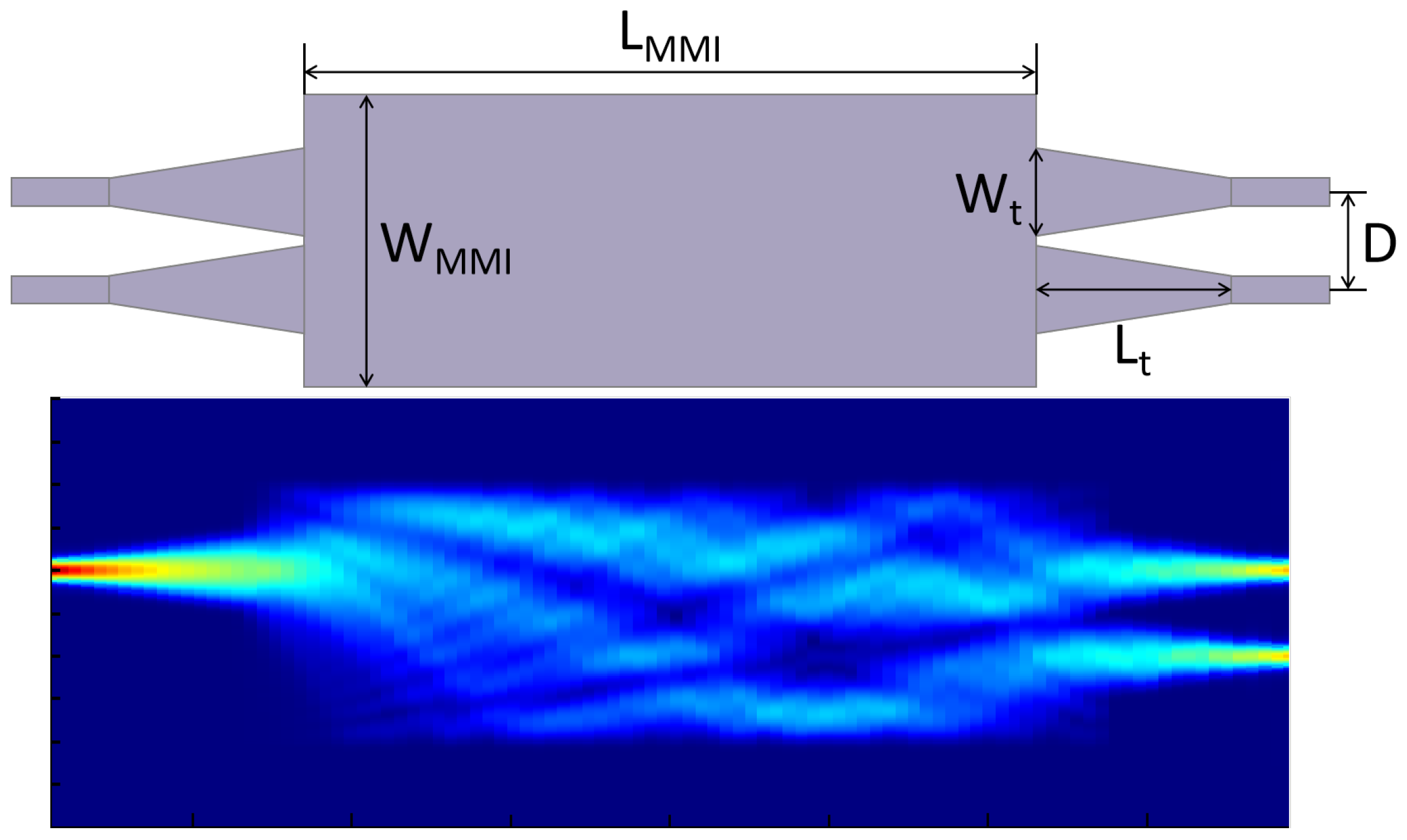
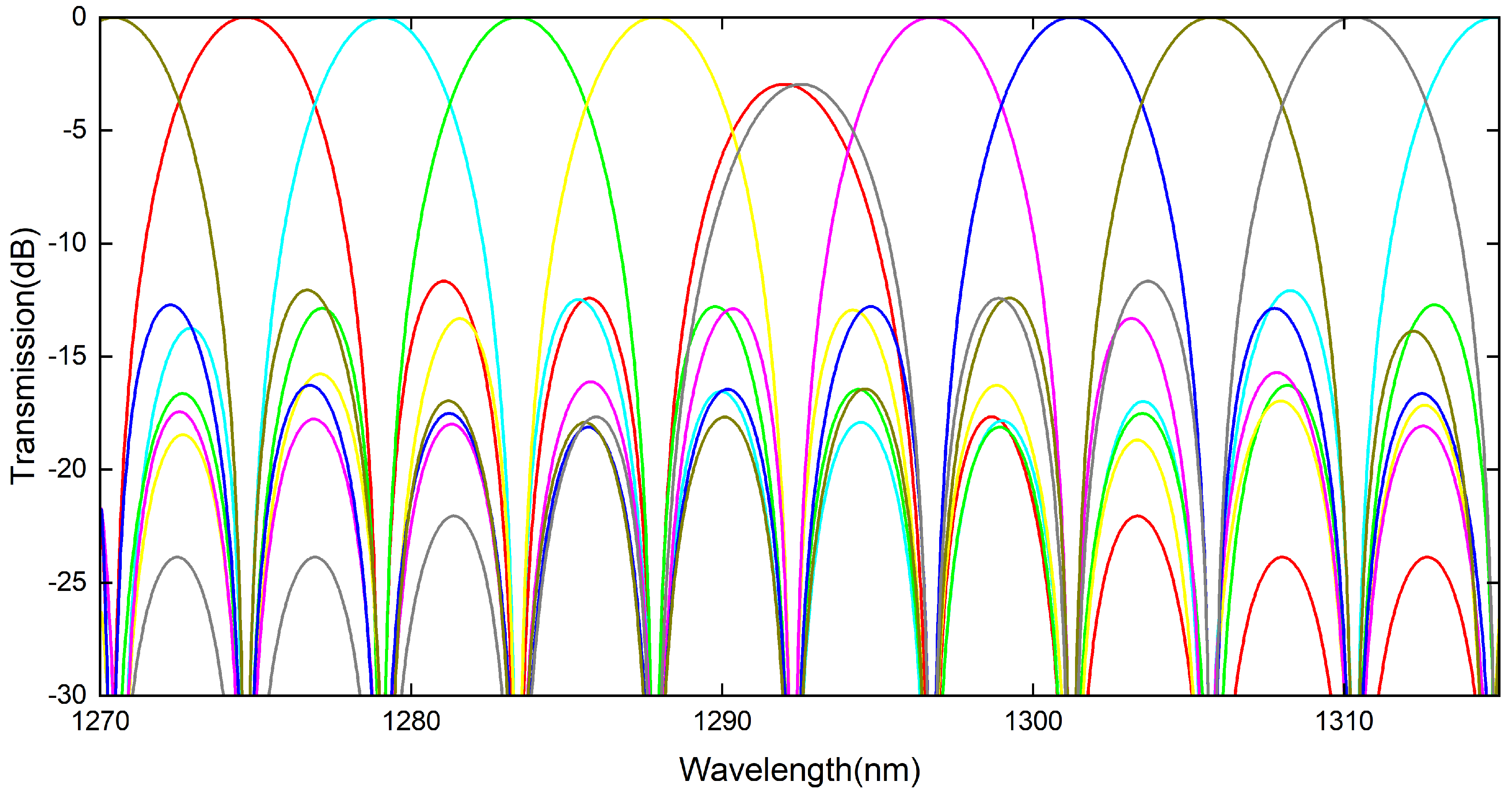
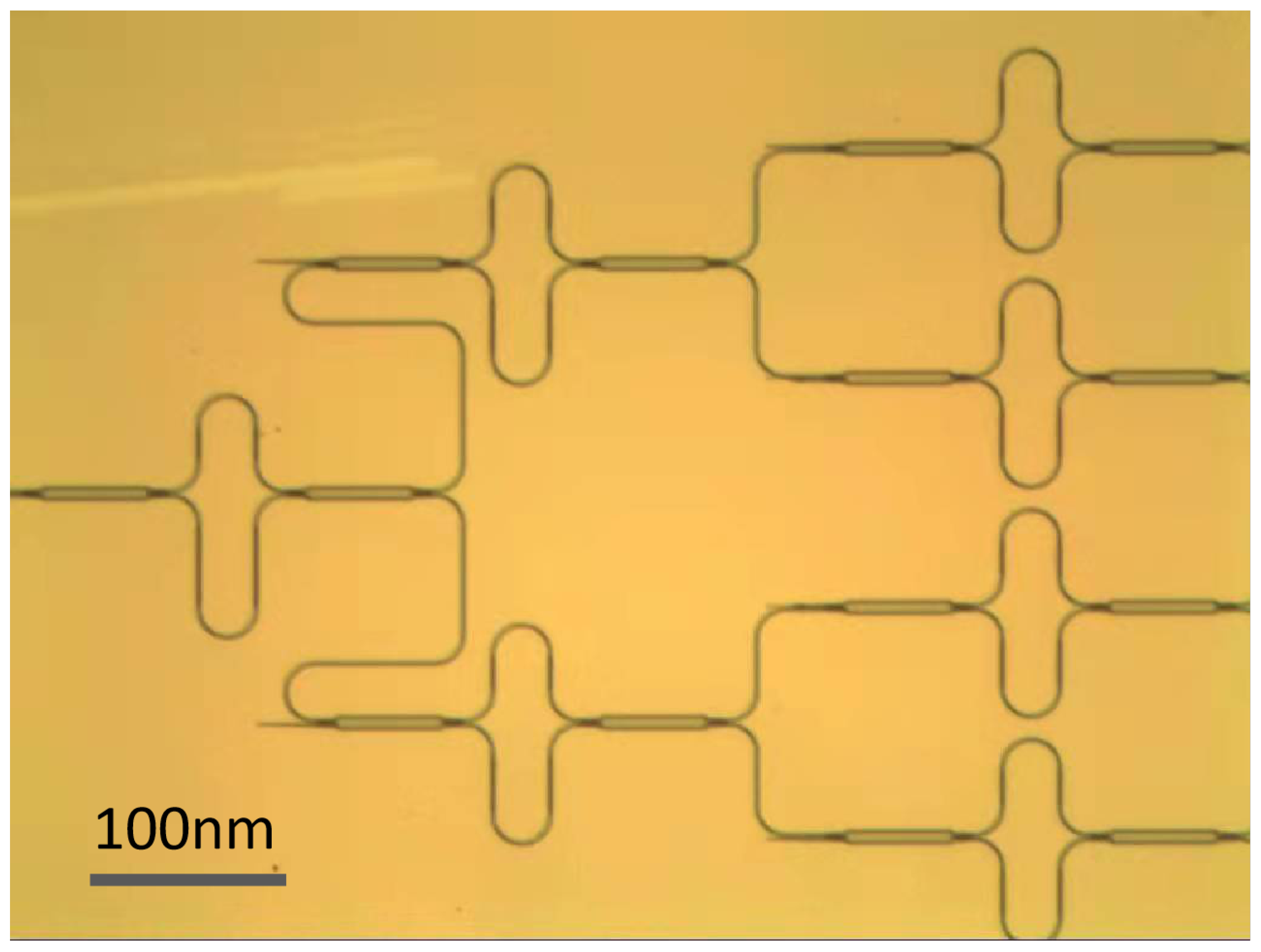
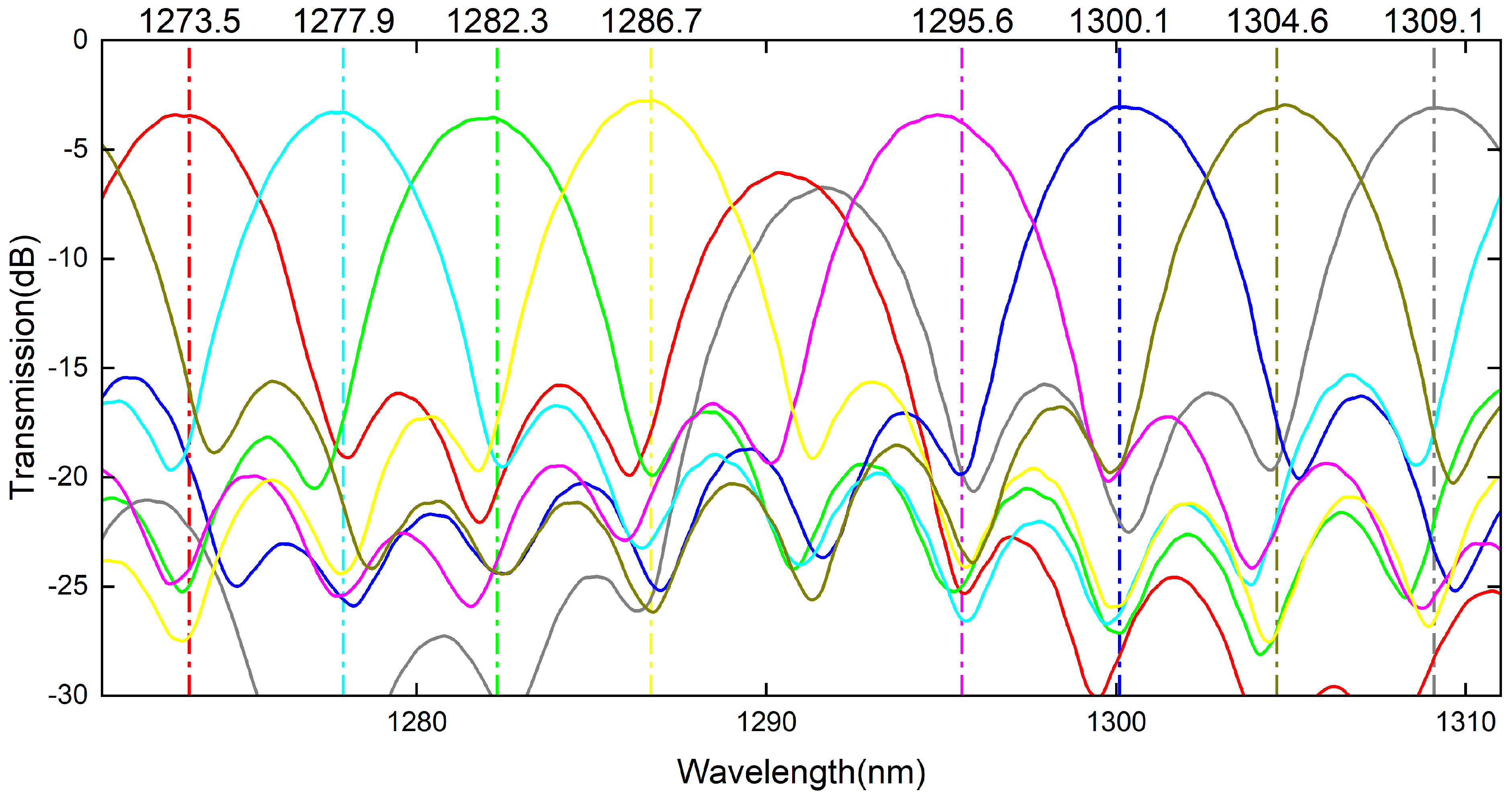
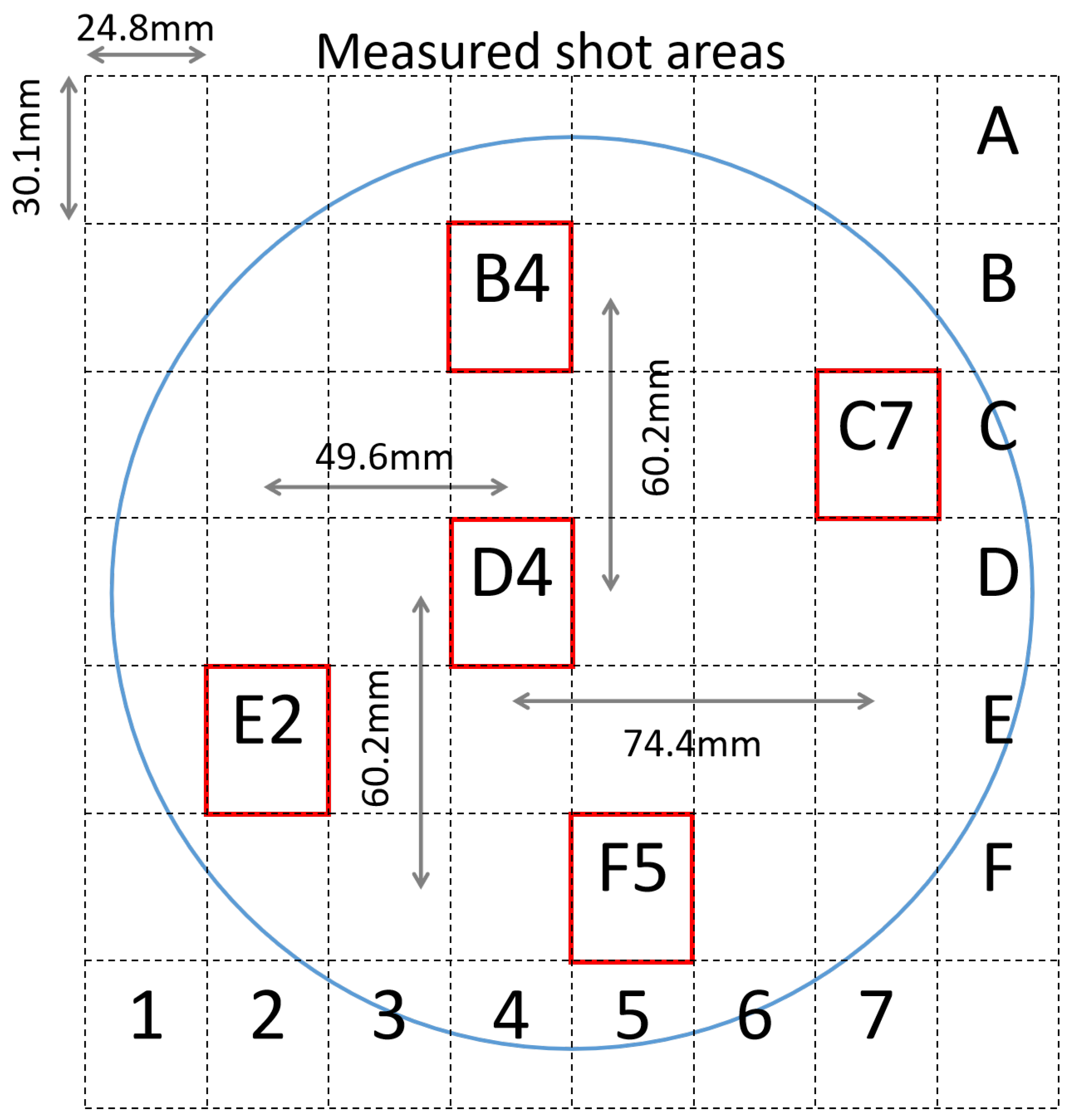

| Lane | Ch1 | Ch2 | Ch3 | Ch4 |
| Wavelength (nm) | 1273.5 | 1277.9 | 1282.3 | 1286.7 |
| Span (nm) | 1272.55–1274.54 | 1276.89–1278.89 | 1281.25–1283.27 | 1258.65–1287.68 |
| Lane | Ch6 | Ch7 | Ch8 | Ch9 |
| Wavelength (nm) | 1295.6 | 1300.1 | 1304.6 | 1309.1 |
| Span (nm) | 1294.53–1296.59 | 1299.02–1301.09 | 1303.54–1305.63 | 1308.09–1310.19 |
| MZIs | Total Length (m) | |
|---|---|---|
| 1st | 48.4 | |
| 2st_A | 24.2 | |
| 2st_B | 24.53 | |
| 3rd_A | 6.05 | |
| 3rd_B | 12.21 | |
| 3rd_C | 12.156 | |
| 3rd_D | 12.264 |
| Lane | Ch1 | Ch2 | Ch3 | Ch4 |
| IL(dB) | −3.45 | −3.30 | −3.57 | −2.77 |
| Crosstalk (dB) | −12.54 | −14.13 | −13.91 | −15.15 |
| Deviation (nm) | −0.4 | 0 | −0.1 | +0.06 |
| Lane | Ch6 | Ch7 | Ch8 | Ch9 |
| IL (dB) | −3.77 | −3.06 | −3.08 | −3.10 |
| Crosstalk (dB) | −16.08 | −16.42 | −14.43 | −15.06 |
| Deviation (nm) | −0.7 | +0.08 | +0.23 | +0.1 |
| Lane | IL (dB) | Deviation (nm) | Lane | IL (dB) | Deviation (nm) |
|---|---|---|---|---|---|
| Ch1 | −3.25 ± 0.57 | −0.4∼+0.13 | Ch6 | −2.56 ± 0.5 | −0.07∼+0.12 |
| Ch2 | −2.88 ± 0.42 | −0.32∼−0.05 | Ch7 | −2.60 ± 0.55 | −0.04∼+0.01 |
| Ch3 | −3.13 ± 0.79 | −0.52∼+0.05 | Ch8 | −2.75 ± 0.4 | −0.59∼+0.32 |
| Ch4 | −2.61 ± 0.44 | −0.28∼+0.06 | Ch9 | −2.88 ± 0.8 | −0.02∼+0.14 |
Publisher’s Note: MDPI stays neutral with regard to jurisdictional claims in published maps and institutional affiliations. |
© 2022 by the authors. Licensee MDPI, Basel, Switzerland. This article is an open access article distributed under the terms and conditions of the Creative Commons Attribution (CC BY) license (https://creativecommons.org/licenses/by/4.0/).
Share and Cite
Zhao, Z.; Li, Z.; Niu, J.; Zhang, G.; Chen, H.; Fu, X.; Yang, L. Eight-Channel LAN WDM (De)Multiplexer Based on Cascaded Mach–Zehnder Interferometer on SOI for 400GbE. Photonics 2022, 9, 252. https://doi.org/10.3390/photonics9040252
Zhao Z, Li Z, Niu J, Zhang G, Chen H, Fu X, Yang L. Eight-Channel LAN WDM (De)Multiplexer Based on Cascaded Mach–Zehnder Interferometer on SOI for 400GbE. Photonics. 2022; 9(4):252. https://doi.org/10.3390/photonics9040252
Chicago/Turabian StyleZhao, Zhizun, Zhen Li, Jiaqi Niu, Gaolu Zhang, Hongliang Chen, Xin Fu, and Lin Yang. 2022. "Eight-Channel LAN WDM (De)Multiplexer Based on Cascaded Mach–Zehnder Interferometer on SOI for 400GbE" Photonics 9, no. 4: 252. https://doi.org/10.3390/photonics9040252
APA StyleZhao, Z., Li, Z., Niu, J., Zhang, G., Chen, H., Fu, X., & Yang, L. (2022). Eight-Channel LAN WDM (De)Multiplexer Based on Cascaded Mach–Zehnder Interferometer on SOI for 400GbE. Photonics, 9(4), 252. https://doi.org/10.3390/photonics9040252





